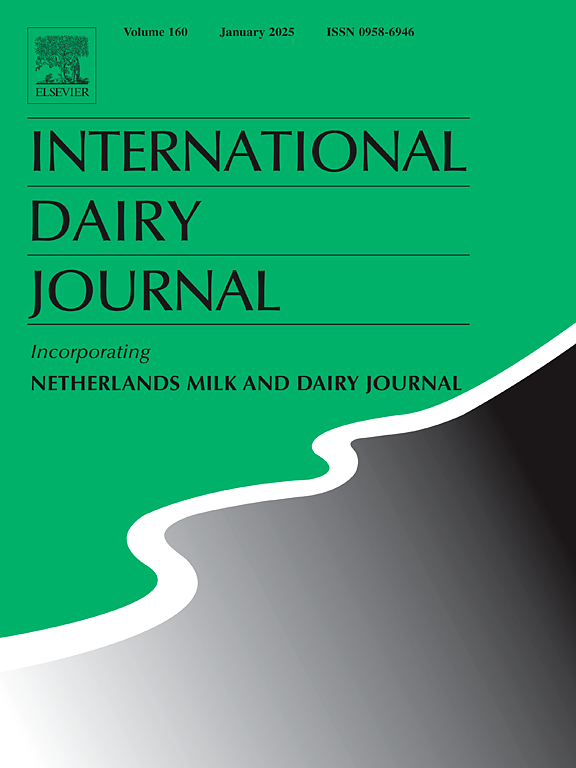Risk of Pseudomonas spp. in raw milk: Biofilm formation and enhanced peptidase production
IF 3.4
3区 农林科学
Q2 FOOD SCIENCE & TECHNOLOGY
引用次数: 0
Abstract
Pseudomonas spp. represent a major risk for milk spoilage due to the production of heat-resistant peptidases. In this study, the capacity of Pseudomonas strains for biofilm formation and peptidase production on different surfaces was investigated under realistic cold-operating conditions. The differences in the bacterial composition of raw milk-associated biofilms after 6-day incubation at 20 °C and 6 °C were visualized using scanning electron microscopy (SEM). Peptidase production was analysed qualitatively on skimmed milk agar and determined quantitatively using a fluorescamine assay. This assay was also used to compare the peptidase activities between biofilm-associated and corresponding planktonic cells in UHT milk as growth medium. Crystal violet staining revealed comparable biofilm formation capacities on stainless steel und rubber at 6 °C for 6 days, although strain- and surface-specific effects were observed. SEM analysis visualized the ability of raw milk-associated microorganisms to form biofilms on stainless steel and rubber surfaces to be temperature-dependent. Quantification of the peptidase activity of biofilm-associated and planktonic cells also revealed strain-specific effects. Interestingly, it was noted that biofilm-associated cells showed a significant (p ≤ 0.01) almost 50-fold higher average peptidase activity when compared to corresponding activities of planktonic cells. In particular, for P. proteolytica L1-105, the biofilm-associated cells were 190 times more peptidase-active compared to the planktonic growth form. These results indicate that biofilms may represent an important entry route of Pseudomonas spp. into raw milk and may contribute to milk spoilage through increased peptidase production even at refrigeration conditions.
原料奶中假单胞菌的风险:生物膜的形成和增强肽酶的产生
假单胞菌是牛奶变质的主要风险,因为它产生耐热肽酶。在这项研究中,假单胞菌菌株在实际的冷操作条件下在不同表面形成生物膜和产生肽酶的能力进行了研究。在20°C和6°C条件下培养6天后,利用扫描电镜(SEM)观察原料奶相关生物膜细菌组成的差异。在脱脂乳琼脂上定性分析了肽酶的产生,并用荧光素测定法定量测定。本实验还比较了UHT乳中生物膜相关细胞和相应浮游细胞的肽酶活性。结晶紫染色显示,在6°C下,不锈钢和橡胶在6天内形成生物膜的能力相当,尽管观察到菌株和表面特异性效应。扫描电镜分析可视化了原料奶相关微生物在不锈钢和橡胶表面形成生物膜的能力,这取决于温度。生物膜相关细胞和浮游细胞的肽酶活性定量也显示了菌株特异性效应。有趣的是,与浮游细胞相比,生物膜相关细胞的平均肽酶活性显著(p≤0.01)高出近50倍。特别是,对于P. proteolytica L1-105,生物膜相关细胞的肽酶活性是浮游生长形式的190倍。这些结果表明,生物膜可能是假单胞菌进入原料奶的重要途径,即使在冷藏条件下,也可能通过增加肽酶的产生而导致牛奶变质。
本文章由计算机程序翻译,如有差异,请以英文原文为准。
求助全文
约1分钟内获得全文
求助全文
来源期刊

International Dairy Journal
工程技术-食品科技
CiteScore
6.50
自引率
9.70%
发文量
200
审稿时长
49 days
期刊介绍:
The International Dairy Journal publishes significant advancements in dairy science and technology in the form of research articles and critical reviews that are of relevance to the broader international dairy community. Within this scope, research on the science and technology of milk and dairy products and the nutritional and health aspects of dairy foods are included; the journal pays particular attention to applied research and its interface with the dairy industry.
The journal''s coverage includes the following, where directly applicable to dairy science and technology:
• Chemistry and physico-chemical properties of milk constituents
• Microbiology, food safety, enzymology, biotechnology
• Processing and engineering
• Emulsion science, food structure, and texture
• Raw material quality and effect on relevant products
• Flavour and off-flavour development
• Technological functionality and applications of dairy ingredients
• Sensory and consumer sciences
• Nutrition and substantiation of human health implications of milk components or dairy products
International Dairy Journal does not publish papers related to milk production, animal health and other aspects of on-farm milk production unless there is a clear relationship to dairy technology, human health or final product quality.
 求助内容:
求助内容: 应助结果提醒方式:
应助结果提醒方式:


